The Magic of MAPP
advertisement
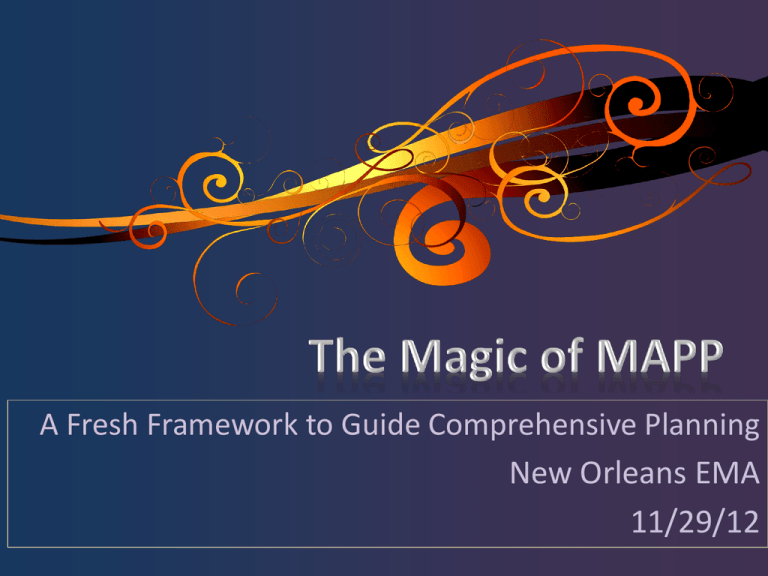
A Fresh Framework to Guide Comprehensive Planning New Orleans EMA 11/29/12 Presenters o o o FRAN LAWLESS, Director, City of New Orleans Health Department, Office of Health Policy [Grantee] BRANDI BOWEN, Program Director, New Orleans Regional AIDS Planning Council ERIKA SUGIMORI, Health Planner, New Orleans Regional AIDS Planning Council Audience Expectations o What are you hoping to get out of this session? Objectives o o o Be able to describe key components of the MAPP process and how MAPP can be used to develop and inform comprehensive planning. Be able to identify additional resources to incorporate the MAPP process into local and state planning processes. Be able to indicate how using the MAPP process can facilitate developing goals, strategies, and activities aligned to support the National HIV/AIDS Strategy. NEW ORLEANS STORY August 2011 What’s out there? Mobilizing for Action through Planning & Partnerships MAPP Process Phase 1 – Orientation, Timelines, Partnerships Phase 2 – Visioning Phase 3 – Community Assessments Phase 4 – Identifying Strategic Issues Phase 5 – Identifying Goals and Strategies Phase 6 – Action and Monitoring 8 MAPP Handbook • Expectations of each specific phase • Key questions • TIPS • Worksheets and other tools to aid discussion, maintain focus and move forward PHASE 1 Orientation, Timelines, Partnerships 10 Phase 1 – TAKE YOUR TIME 11 Types of Stakeholders • Consumers • Planning Council Representatives • Ryan White Part A Grantee • Other Ryan White Parts Grantees • Office of Public Health (CDC Grantee) • HOPWA Representatives • Greater New Orleans Foundation • Other health and housing programs 12 PHASE 2 Visioning 13 Phase 2 – GUIDING LIGHT 14 VISION NOEMA’s vision is a high quality comprehensive coordinated HIV care system to promote improved overall health outcomes, through a care system devoid of stigma and discrimination, free from fragmentation, consistent with consumer empowerment and choices, treatment guidelines, and availability and access for all, ultimately resulting in fewer new infections in the New Orleans area. 15 VALUES to support the VISION EXAMPLES: … providers recognize their strengths and core competencies and have relationships with other agencies to provide specialized services for the overall success of the client. … community resources and policies meet the needs of PLWHA every day and each one of us support cultural sensitivity and reductions in stigma every day. … the system of HIV care supports client selfmanagement with seamless transitions across levels of care, the support necessary to graduate to the next level of self-management along with policies that support clients at all levels, even the most low acuity self16 managing clients. PHASE 3 Community Assessments 17 Phase 3 – DATA BACKBONE 18 SAMPLE DATA • • • • • • • Consumer Needs Assessment Case Manager Survey Case Manager Focus Group SWOT Client Satisfaction Survey Quality of Life Consumer Focus Group Health Status Data Compilation 19 PHASE 4 Strategic Issues 20 Phase 4 – CRITICAL CHALLENGES 21 SOME CHALLENGES • System fragmentation • Lack of mind/body/health connective opportunities & limited empowerment/ education opportunities • Limited civic engagement among consumers • Lack of comprehensive sexual health education • LGBTQ Stigma • Over incarceration • Economic climate and low priority of health and education on State agenda 22 PHASE 5 Goals & Strategies 23 Phase 5 – WHAT? & HOW? 24 NOEMA’s Transmutation Plan PHASE 6 Action & Monitoring 26 Phase 6 – JUST DO IT 27 Goal 1: Reduce the number of new infections Timeframe Activities Parties Strategy 1.1: Convene a workgroup that includes all key stakeholders (e.g., primary and secondary preventions partners) to develop and implement an Early Identification of Individuals Living with HIV/AIDS (EIIHA) strategy in Years 1, 2 and 3. By May 2012 By May 2012 By May 2012 By September 2012 Quarterly, after September 2012 Activity 1.1a: Identify a physical venue to host EIIHA strategy discussions. Activity 1.1b: Invite multilevel partners to form an 'EIIHA Strategy Workgroup' specific to the development and implementation of the EIIHA strategy. Activity 1.1c: The 'EIIHA Strategy Workgroup' will adopt a planning framework and meeting schedule. Activity 1.1.d: The 'EIIHA Strategy Workgroup' will inform an EIIHA strategy, including an impact evaluation plan. Activity 1.1.e: The 'EIIHA Strategy Workgroup' will meet as appropriate to coordinate, regularly assess progress and measure impact. Lead: NORAPC [Comprehensive Planning Committee] & OHP Planned Partners: OPH SHP, LPHI, HIV Prevention and Care Providers, Emergency Room testers, Linkage to Care staff , PLWH, HIV Focus FY 2012 (March 2012 - February 2013) Goal 1 2 3 4 5 6 7 Strategy 1.1 1.2 1.4 2.1 2.2 2.5 3.1 3.3 4.1 4.2 5.1 5.2 5.3 5.4 5.5 5.7 6.1 6.2 6.6 *7.1 *7.2 *7.3 5 6 7 8 9 10 11 12 1 2 Continuum of Care o No wrong or right way, or single way to do it. o Each local area context will determine how the system should be implemented. o Collaboration and coordination is crucial. Collaboration & Coordination o o HRSA expects planning councils and grantees to collaborate and coordinate with key partners providing HIV prevention, treatment and support to implement a responsive and ideal COC. Key local partners: o o o o Other Ryan White Parts (B, C, D & F) Medicaid VA Other continuums of care (e.g., housing, behavioral health) Comprehensive Plan Purpose o o o o o o A living document Roadmap for the grantee Continually updated as needed Reflecting the community’s vision and values Considers other relevant plans Considers changing context Key Items for Inclusion National HIV/AIDS Strategy o Healthcare Reform o HIV as a chronic disease o o o o Early HIV detection, Engagement in care, Reduction in disparities in health outcomes ROADMAP for Improvement o What are we trying to accomplish? o How will we know that a change is an improvement? o What changes can we make that will result in improvements? Key Elements of BREAKTHROUGH Improvement o Will to do what it takes to change to a new system o Ideas on which to base the design of an improved system o Execution of the ideas NOEMA’s Transmutation Plan Why MAPP worked well for the facilitators… No consultant fees o Provided added confidence in a plan that was data-driven, and developed directly from community input o Structure already laid out allowing energy to be spent on local flair and focus o Why MAPP worked well for the planning council … User-Friendly o Wholistic planning process that engaged diverse stakeholders o The process led to a strong viable living document in full support of the National HIV/AIDS Strategy o Why MAPP worked well for the grantee… Inclusive process that encouraged robust participation o Valued and incorporated input from all key stakeholders o Thought-provoking and stimulating process that led to a measurable and achievable roadmap o Share Senselessly & Steal Shamelessly! “Picasso had a saying – ‘good artists copy, great artists steal’ – and we have always been shameless about stealing great ideas”. Steve Jobs HAVE FUN Transmutation Shedding the old skin for growth and change Imbue your process with a fresh perspective for planning, monitoring and evaluation SET IT UP RIGHT Give it a home o Ensure those that bought in are involved in implementation o Carry it around with you EVERYWHERE and recruit others o WORK PLAN IMPLEMENTATION Existing spaces o Partner spaces o Newly created spaces o Peripherally effected spaces o PERMEATION Community Heavily Involved In Plan Development Individuals Working on Your Goals even Peripherally TIP: Frequent Review & Education to Ensure Understanding Plan = Compilation of Easy to Follow & Justified Items of Focus -Reflective of Community Need & Expertise Community(ies) Mobilized TIP: Grantee & PC Staff Involvement (If Buy-in is Achieved) Participants & Organization Members will Share with Others TIP: Identify and promote opportunities for people to help TIP: Flexibility GRANTEE’S ROADMAP o o o Implementation Monitoring Evaluation NACCHO Site http://www.naccho.org/topics/ infrastructure/mapp/index.cfm Contact Info FRAN LAWLESS – Director, OHP flawless@nola.gov (504) 658-2800 BRANDI BOWEN – Program Director, NORAPC brandi@norapc.org (504) 821-7334 ERIKA SUGIMORI – Health Planner, NORAPC erika@norapc.org (504) 821-7334
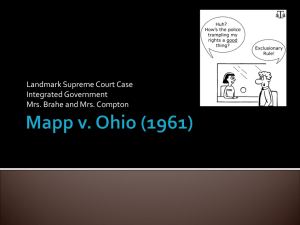
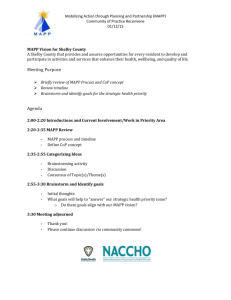


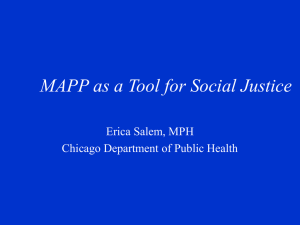
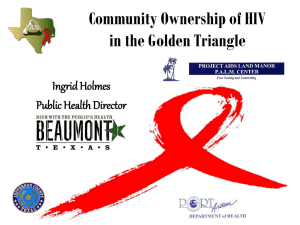
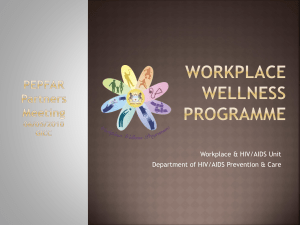


![[Educational Organizations: Universities, Colleges and Schools]](http://s3.studylib.net/store/data/005855885_1-5779bea055a993e7057979e3ec38faa7-300x300.png)